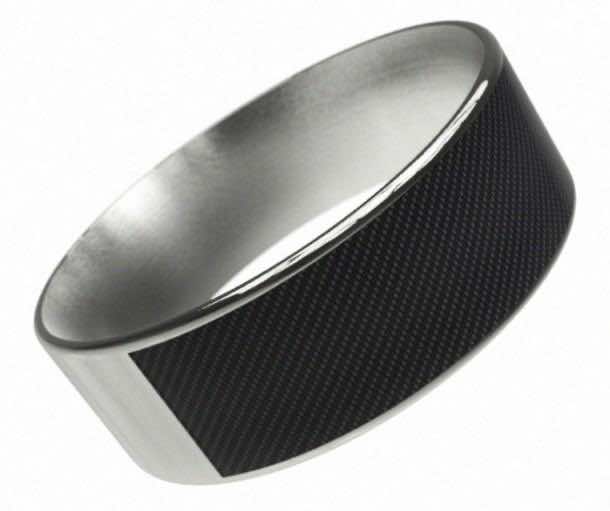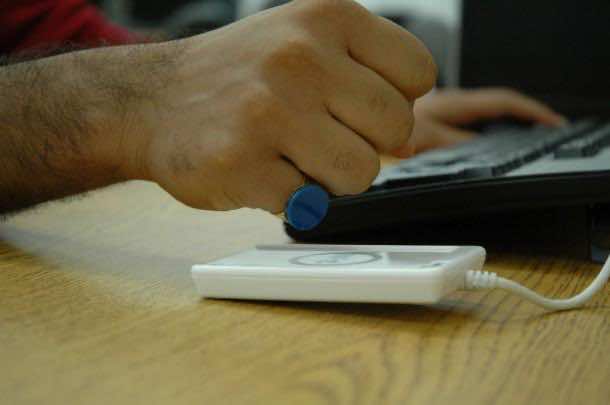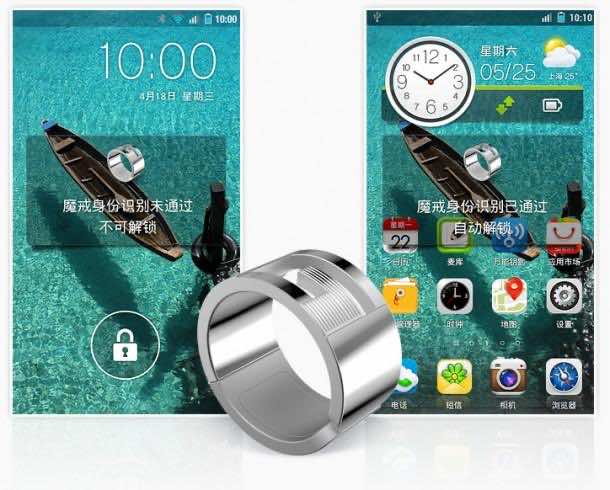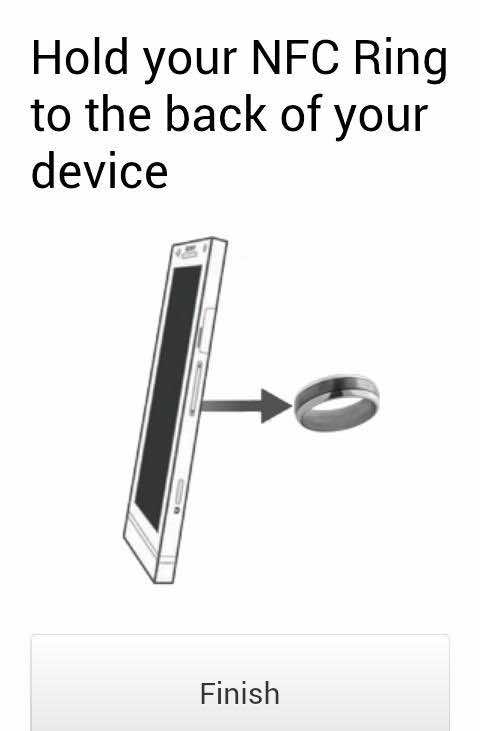 At some point in life, everybody is going to have to wear a ring. Why not get practical with that little piece of jewellery? That is exactly why John McLear, after working on this project for over a year, invented the NFC Ring. This isn’t some ordinary ring, but is in fact a gadget used to unlock doors, mobile phones and to transfer information and link people. What makes NFC Ring different from all other such gadgets is that it glides right onto your finger requiring no updates, no fuss and no charging. Ever.
At some point in life, everybody is going to have to wear a ring. Why not get practical with that little piece of jewellery? That is exactly why John McLear, after working on this project for over a year, invented the NFC Ring. This isn’t some ordinary ring, but is in fact a gadget used to unlock doors, mobile phones and to transfer information and link people. What makes NFC Ring different from all other such gadgets is that it glides right onto your finger requiring no updates, no fuss and no charging. Ever.
How do you use the NFC ring? When you take your phone out of your pocket, just slide your hand under and the NFC Ring will unlock it. It couldn’t be any simpler. A third party application is required for this though. Several exist, so you can pick your own from the Google play store.
A lot of people have privacy concerns regarding the usage of the NFC ring. To solve this, the ring comes with two inlays, public and private so allowing the user to keep personal information as private as he wants.
The ring can be used to do so much more than unlocking cell phones and tablets. Want to be able to use it to unlock your house? All you need to do is to get a hold of an NFC enabled door lock, install it and voila! And the possibilities certainly do not end here. You can use your NFC Ring to share WiFi information, links to websites, contact information or whatever you think is suitable to be passed securely to your friends, smart phones and tablets. You can also use your NFC Ring to start apps with custom settings, making it a really easy way to personalize the app experience to be compatible with your ring. Let your own ideas loose, as to how to use your NFC Ring.
 The journey for the NFC team hasn’t been easy. After a whole year of efforts to put John McLear’s idea to practical use, the team started prototyping on a 3D printer using Tinkercad to create renders. All of their software is open source, developed in Apache Cordova
The journey for the NFC team hasn’t been easy. After a whole year of efforts to put John McLear’s idea to practical use, the team started prototyping on a 3D printer using Tinkercad to create renders. All of their software is open source, developed in Apache Cordova
Among other problems faced when developing the ring, the most significant ones were the Metal and RFID. Naturally, metal absorbs the RFID signal from the antenna which means that as the process of induction fails, so does the ability to communicate with the ring. McLear, after several months of rigorous research and development, was finally able to solve this problem by using an intermediate layer between the Ring and the inlay. That is when the next problem arose. What material could they use that would be thin enough to effectively serve as the intermediate layer.
 After a number of trips to China later the team finally was able to source a 13mm intermediate layer and that is when they assembled their first prototype. Initially five prototype rings were ordered and distributed to fellow tech enthusiasts, and that was when several other glitches with the style, fitting and security were discovered.
After a number of trips to China later the team finally was able to source a 13mm intermediate layer and that is when they assembled their first prototype. Initially five prototype rings were ordered and distributed to fellow tech enthusiasts, and that was when several other glitches with the style, fitting and security were discovered.
The style issue wasn’t much of a problem though and was addressed by allowing the NFC Ring owners to customize their own style and also by providing a variable set of colour choices.
The team did not take long to figure out a solution for the security issue. The team resolved that problem a few months later by adding an additional inlay opposite the original inlay. This solved the security issue by creating an interference area stopping any powerful antennas being able to complete a full induction process and by using different hand gestures for different actions (closed fist for public, open hand for private).
The issue that took the longest to solve not to mention the immense expenses was the comfortable fitting issue. The reason being that the thinnest inlay on the market at the time of initial development was no less than 12mm. This meant that the ring had to be 13mm wide. Who would wear a ring as wide as 13mm especially when the ring was initially designed to be worn permanently as though a wedding band. After five pretty expensive prototypes going to waste, the team was finally able to put together their very own 6mm NFC Inlay. They finally decided on the NTAG203 chip because it was actually an NFC chip unlike some of the cheaper alternatives being used in the market.
 The NFC inlays are not mass produced yet so they would turn out to be quite expensive. The Minimum Order Quantity of the NFC inlays is 10,000 units. Because the manufacturers have been working on this for over a year, the prototyping process is now complete. And because of all the hit and trial efforts they know what does and doesn’t work so all they need now is funds for the mass production run.
The NFC inlays are not mass produced yet so they would turn out to be quite expensive. The Minimum Order Quantity of the NFC inlays is 10,000 units. Because the manufacturers have been working on this for over a year, the prototyping process is now complete. And because of all the hit and trial efforts they know what does and doesn’t work so all they need now is funds for the mass production run.
With the NFC ring in hand and production lined up and social media forums going making the phenomenal new technology viral, they are ready for business.
So what does the future hold for the NFC Ring technology? The team is working on creating an open source platform that will enable third parties to adopt the NFC Ring and consider making their devices NFC compatible.
The NFC team believes in sharing as much information as possible so they also publish useful links to documentation and other reference points on our Github organization site. This includes 3D models so you can customise and 3D print your own ring at home!
Keeping the bigger picture in mind, their ultimate goal is to produce a ring that will make day to day life better for users. Further R&D is underway so that the ring can eventually have more applications such as a pedometer, to monitor your heart rate and much more.
So what exactly is the process, you ask? It’s quite simple. Once the NFC kickstarter is successful you will receive an email. The email will guide you along the way. It will include a link to a page where you will be asked to take a photo of your hand holding a magnetic strip, the size of the finger you want your ring to be on, can be measured. If you don’t have a webcam, or you wish to avoid this process, you can always use another means to find your ring finger size and enter it manually.
Next you will be asked a few product-specific questions such as what colour inlays you would like and if you have chosen a custom inlay design you will be asked to email your design through. Details will be provided based on the size of your ring.
During the delay between Kickstarter finalizing, assuming we hit our target, the order with the RFID supplier will already have been placed, and team will run their first MOQ inlay run of 100k Units. The lead time on these is a few weeks so during that period they will begin manufacturing inlay covers, rings and RFID reflective material.
Three weeks after Kickstarter finalises, the inlays, inlay covers and reflective material should be ready to start manufacturing the first run of rings. The minimum run will be 1000 units and will take roughly two weeks to complete. All manufacturing factories for the NFC rings and the whole production line are in China. To ensure that they can handle the distribution requirements of the project, practice shipping runs between each other have already been tried out.
The company is working with a ring factory that has a proven track record at delivering Kickstarter projects, this factory is responsible for taking orders, manufacturing the ring shape, and all the mechanical processes like cutting the covers and reflective material to size, inserting the components into the ring and sealing with the coating. The factory will also be responsible for any custom printing and engraving requested.
The Kickstarter funds should clear 4 weeks after the campaign finishes, at this point depending on how much is cleared, we will either manage completion from China or from the UK.
The shipping and distribution process is handled by a distribution provider CritSuccess, in the US to serve the American, which has a track record at delivering on Kickstarter projects similar to this one. Europe distribution is being handled from the UK and Asia distribution from China. Depending on scale we expect it will take up to 4 weeks for the rings to ship from China to the US.
So assuming and adding up four weeks for production, four weeks for shipping and then a further one week for handling, your ring should be at your doorstep in about 9 weeks after you place your order.
The suppliers do, however face some obstacles while delivering to other countries. They have two distribution centres and are working with previous successful kickstarter projects to help them resolve this.
Some mobile phones have very poorly placed NFC antennas. This can lead to weak signal which stops NFC functioning fully with the Ring. The team aims to contribute to a blacklist of mobile phones that they know don’t support NFC functionality well.
The normal NFC Ring still has a few minor defects. It does not work with The S4 and The BlackBerry Z10. This is due to the way that the S4 and Z10 NFC chip-set and where RIM/Samsung place their antenna in their battery making it impossible for those phones to read small NFC Inlays consistently. With these phones you are going to need an alpha sized ring.
The Nexus 7 Tablet has a known bug with initializing the camera for scanning QR Codes, when you try to use a QR code it will crash the app. You can still create actions locally though.
But the Alpha Male Ring is really only for people with big fingers, because of its large size normal size hands will look like dwarf hands.
Something everyone should know before ordering the rings is that all NFC Inlays are shipped, unlocked, so it may be that at some point the manufacturers might decide to send an update to your app that sets them to locked open, this is to stop someone writing a malicious NDEF record to your ring and locking it in that state, because your privacy and security is paramount. A great invention and gadget indeed!


